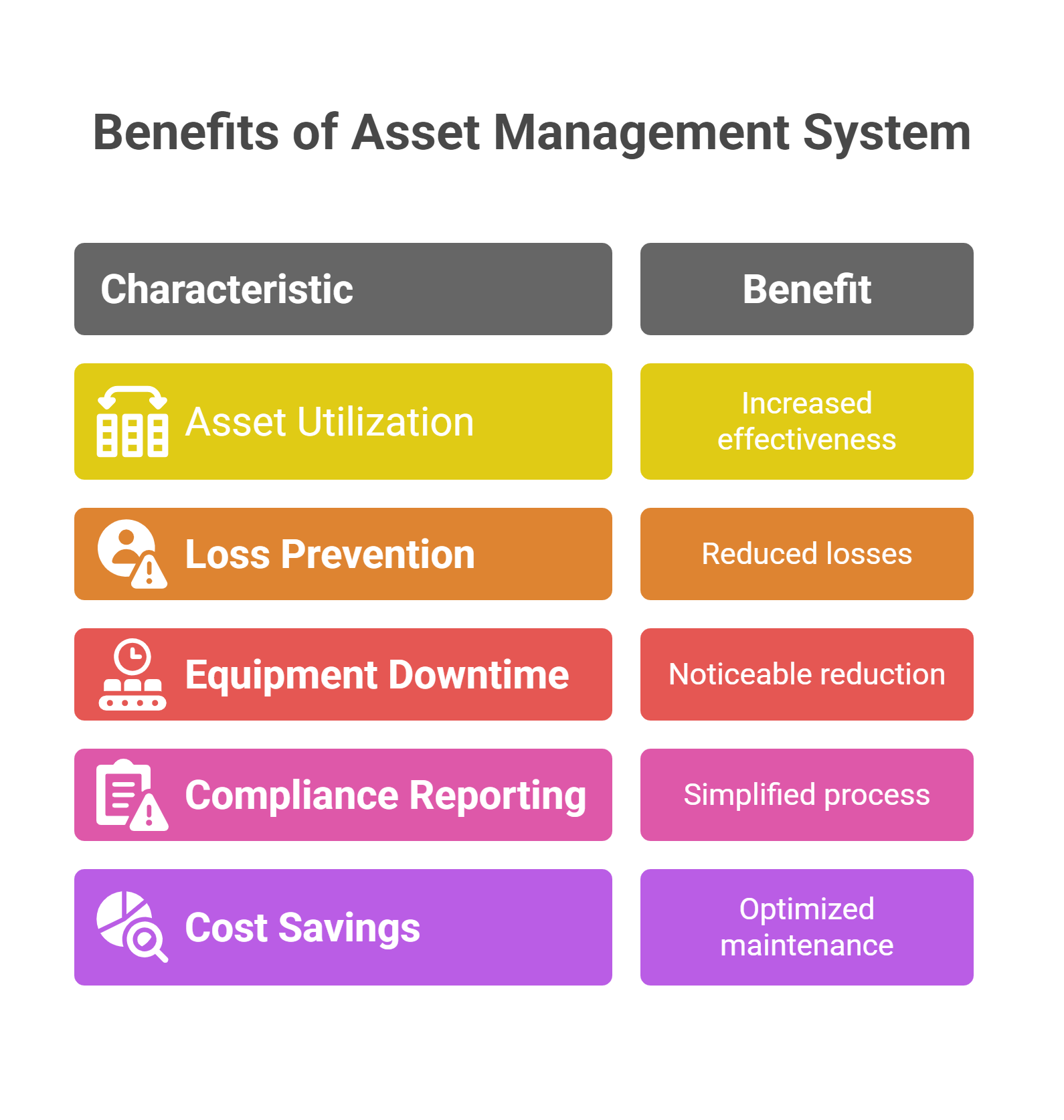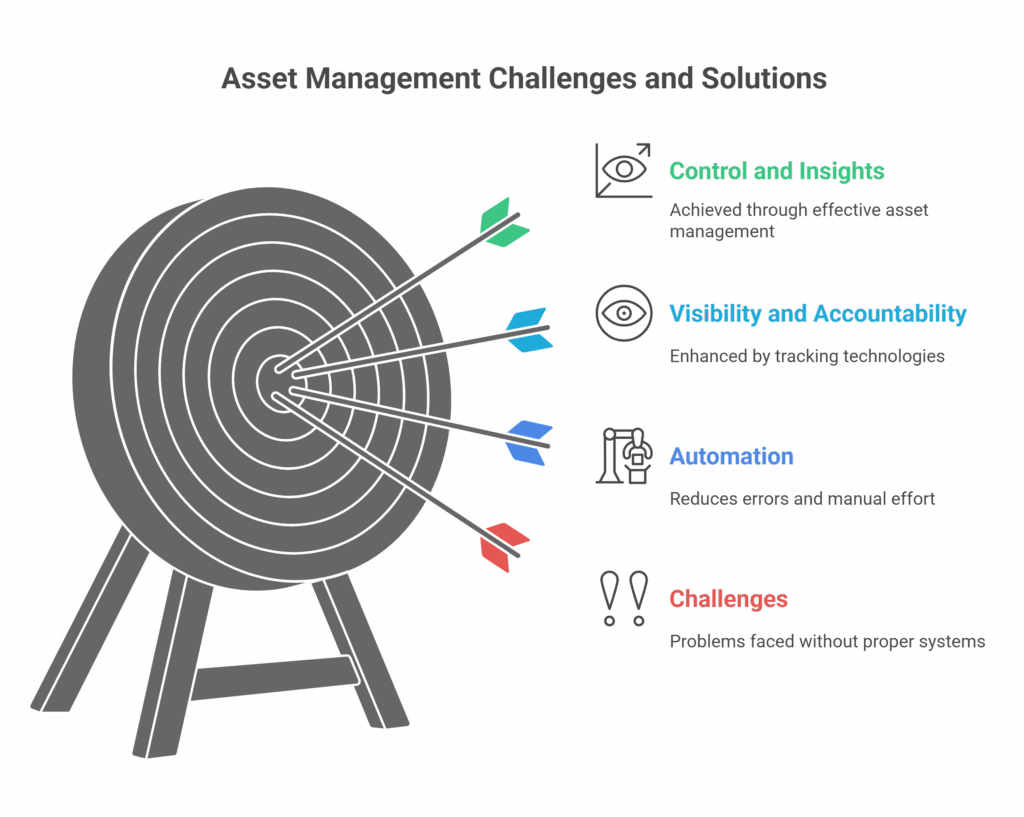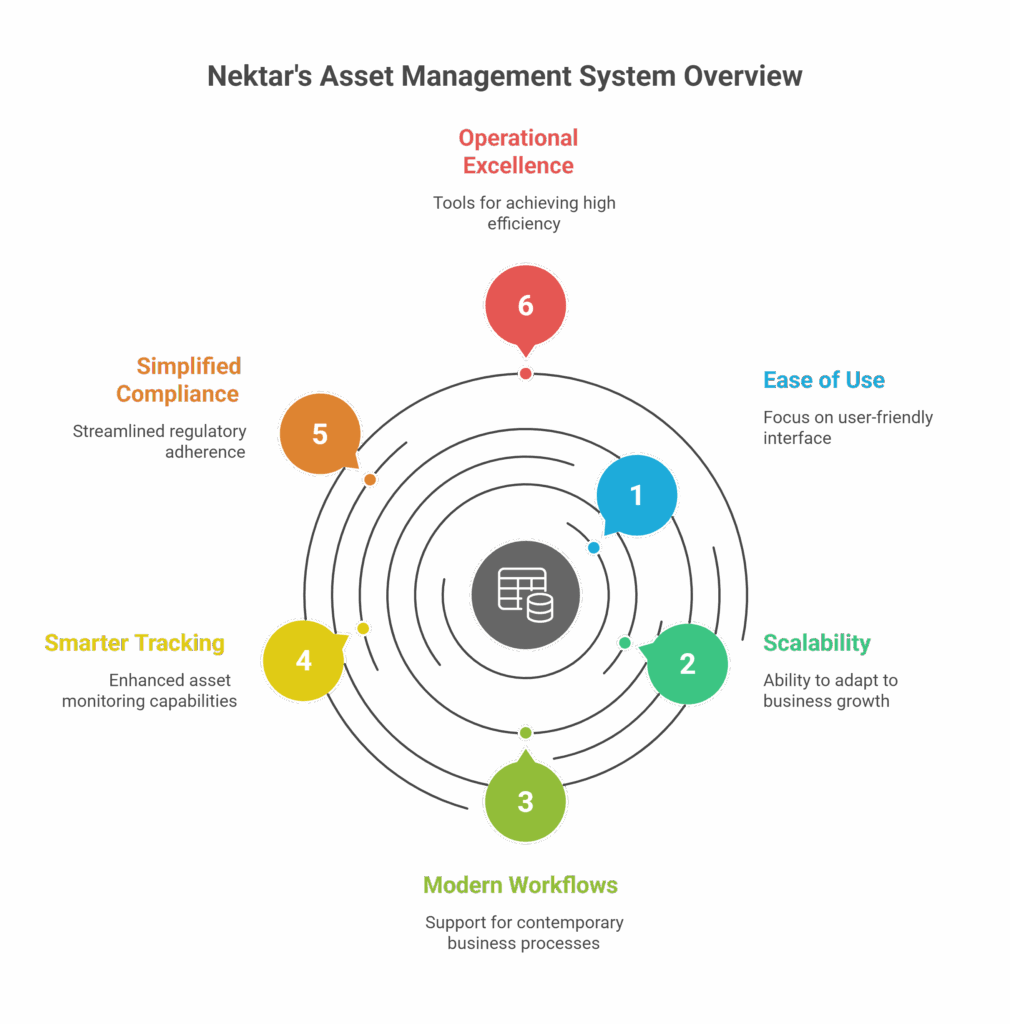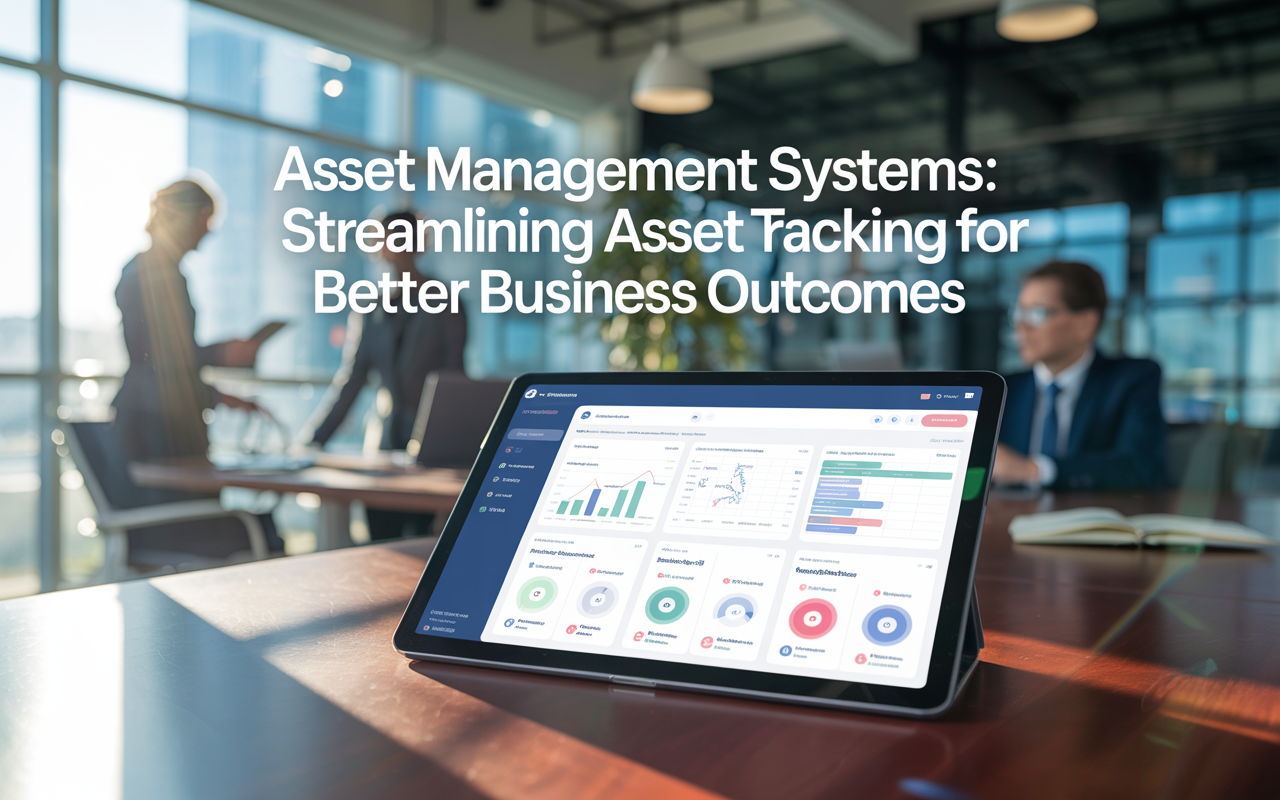Introduction
Ever had that sinking feeling when a crucial piece of equipment goes missing? Missing assets don’t just create headaches; they drain budgets and can throw entire projects off schedule. It’s a common frustration for many organizations that struggle to answer a seemingly simple question: “Where is all our stuff?” The right asset management system isn’t just about keeping tabs on things—it fundamentally reshapes how your resources contribute to your business’s success.
Stick around, and you’ll get the lowdown on:
- How asset management systems boost efficiency and help you stay compliant.
- Why automation and a central hub for your asset information are game-changers for growth.
- What leading tools, like those offered by Nektar, bring to the table for modern companies.
What Is an Asset Management System?
Think of an asset management system as your organization’s command center for everything it owns. It’s a structured approach, blending smart processes with technology, designed to track, monitor, and manage all of your company’s assets from the moment you get them until they’re retired. These aren’t just for big-ticket items; assets can be anything from IT hardware (laptops, servers) and office furniture to heavy machinery, company vehicles, software licenses, and even entire facilities.
These systems typically involve software that offers features like a central asset register, maintenance logs, and tracking capabilities. Some setups might still involve manual data entry, but modern systems lean heavily on automated methods – think barcode scanners, RFID tags, or GPS – to keep information accurate and up-to-date with minimal fuss. This shift from manual to automated means less human error and more time for your team to focus on what matters.
“An asset management system is a systematic way of tracking, monitoring, and managing an organization’s assets to improve productivity, avoid equipment failure.” -Accruent
Why Businesses Need Asset Management Systems
As companies grow, so does their inventory of assets. Keeping track of an ever-increasing number of items manually is, frankly, a recipe for disaster. This growth often brings a higher chance of assets getting lost, stolen, or simply “ghosting” from your records. Add to that the mounting pressure of regulatory reporting requirements and the constant need to make quick, data-backed decisions, and you can see why spreadsheets just don’t cut it anymore.
Many businesses feel the pinch from common pain points: unexpected equipment breakdowns disrupting operations, overspending on unnecessary replacements for items they already own (but can’t find!), or struggling through time-consuming audits. Modern asset management systems directly address these issues by providing clear visibility into asset location, condition, and maintenance history, allowing businesses to operate more smoothly and make smarter financial choices.
“Today’s asset management systems enable businesses of all types to streamline their operations by placing asset information in a central database, enabling them to see trends that take the big picture into account.” -DuraLabel
How Asset Management Systems Work: Key Processes and Data Flows
So, how does the magic happen? It starts with gathering data about each asset. This can be a mix: manual input for initial setup or unique items, and automated methods like scanning barcodes, RFID tags, or IoT sensors for ongoing updates. Each asset usually gets a unique identifier or tag, linking its physical presence to its digital record in the system. The software then acts as a central dashboard, giving you a real-time overview of your asset inventory.
This flow of information is crucial. For instance, data on an asset’s usage and condition can trigger maintenance alerts, helping prevent costly breakdowns. This information doesn’t live in a vacuum either; many asset management systems can share data with other business platforms, like Enterprise Resource Planning (ERP) for financial tracking or compliance management tools for audit trails, creating a connected information network.
“Asset management decision processes are the individual decisions that need be made in every level of decision making, whether that is of a strategic, network, or project focus.” -Scribd
Key Benefits of Implementing Asset Management Systems
Putting a robust asset management system in place brings a wealth of advantages. One of the biggest wins is improved asset utilization. When you know what you have and where it is, you can make sure it’s being used effectively, rather than sitting idle or being underused. This naturally leads to fewer losses from misplacement or theft, as accountability and visibility increase. Another key plus is a noticeable reduction in equipment downtime.
Beyond keeping things running, these systems make compliance reporting much less of a chore. Audit trails are often automated, and reports can be generated quickly, saving valuable time and reducing stress during audit seasons. This efficiency translates directly into cost savings – not just from preventing loss, but also by optimizing maintenance schedules and avoiding rush repairs or unnecessary purchases.

What’s more, by carefully monitoring usage and maintenance, you can actually extend the lifespan of your assets. Proactive upkeep, guided by system data, means equipment lasts longer and performs better. Imagine the time saved during annual physical inventory checks, or the improved accuracy in forecasting future equipment needs. These aren’t small gains; they add up to a more efficient and financially sound operation.
“Asset management benefits are vast, enabling asset managers to: Improve asset acquisition and use. By tracking assets in a central database, reporting is simplified, more comprehensive, and generally error-free.” -DuraLabel
“Asset management system helps improve the profitability and sustainability of a business by streamlining operational workflows.” -EZO
Types of Assets Managed
Asset management systems are incredibly versatile, capable of tracking a wide array of items crucial to an organization’s operations. The most commonly thought-of are physical assets: this includes everything from office equipment like computers and printers, to heavy machinery on a factory floor, fleets of vehicles, specialized tools, and even furniture. Then there are digital assets, an increasingly important category, covering software licenses, digital media, patents, and proprietary data.
Beyond these, facilities themselves can be managed as assets, including buildings and the infrastructure within them. Some systems even help track intangible assets, although this is a more specialized area. Different industries will naturally focus on different asset types. For example, a healthcare provider will prioritize medical devices and patient care equipment , schools will track IT equipment and educational materials , while a manufacturing plant will focus on production machinery and tools.
Core Features to Look for in Asset Management Systems
When you’re evaluating asset management systems, certain core features are non-negotiable for effective operation. At the heart of any good system is a centralized asset database. This is your single source of truth for all asset information, from purchase date and price to current location and condition. Comprehensive asset lifecycle tracking is also vital, allowing you to follow an asset from acquisition through deployment, maintenance, and eventual disposal.
Maintenance scheduling and management capabilities help you stay on top of repairs and preventative care, minimizing unexpected failures. Look for powerful reporting and analytics tools that can turn raw data into actionable insights, helping you spot trends and make better decisions. Integration capabilities are also key, ensuring the system can work smoothly with your existing software stack. Don’t forget location tracking (GPS for mobile assets is a huge plus!) and robust user permissions to control who can see and modify data.
“Businesses can use an asset management system to implement smooth asset tracking, asset monitoring and maintenance processes… from a centralized hub.” -EZO
Cloud-Based vs. On-Premises Solutions
When choosing an asset management system, one of the first decisions is whether to go cloud-based (SaaS) or stick with an on-premises setup. Cloud systems generally offer greater scalability – you can easily adjust your usage up or down as your needs change – and accessibility, as authorized users can access the system from anywhere with an internet connection. Often, the upfront cost for cloud solutions is lower, with a subscription-based model.
On-premises systems, hosted on your own servers, give you direct control over your data and security infrastructure, which can be a preference for organizations with strict data governance policies. The trade-off is usually a higher initial investment in hardware and software, plus the ongoing responsibility (and cost) of maintenance, updates, and IT support. The “right” choice depends on your organization’s size, IT resources, security requirements, and budget. Many find the flexibility and lower maintenance burden of cloud options very attractive.
Common Challenges in Asset Management and How Systems Solve Them
Without a proper system, asset management can be riddled with challenges. Manual tracking methods are notoriously prone to errors – typos, missed entries, outdated information – leading to an inaccurate picture of what you actually own. Asset loss or “ghost assets” (items on the books but physically missing) are common, resulting in wasted resources and budget overruns. A general lack of visibility makes it hard to know where things are, who’s using them, or when they need attention.
Then there’s the compliance overhead; manually preparing for audits can be a massive time sink. Asset management systems tackle these problems head-on. Automation drastically reduces manual errors. Barcode scanning, RFID, and GPS tracking improve accuracy and accountability, making it much harder for assets to vanish. Centralized dashboards provide that much-needed visibility, and automated reporting features generate audit trails and compliance documentation with much less manual effort, giving you clear insights and control.

Integrating Asset Management with Other Business Processes
An asset management system truly shines when it’s not an isolated island of data. Connecting it with other key business platforms creates a powerful, unified view of your operations. For instance, integration with your finance or accounting software allows for accurate depreciation calculations, tracks asset values, and ensures financial records match physical realities. Linking up with procurement systems can streamline the purchasing of new assets and the disposal of old ones.
Maintenance modules benefit hugely from asset data, enabling predictive maintenance and efficient work order management. Integration with facilities management can help coordinate space planning and equipment placement. For IT assets, connection with IT service management (ITSM) tools ensures that hardware and software inventories are always in sync, supporting help desk operations and license management. This interconnectedness fosters a more data-driven environment across the entire organization.
Case Studies: Real Results with Asset Management Systems
The proof, as they say, is in the pudding. Organizations across various sectors have seen remarkable improvements after adopting dedicated asset management systems. Many report a dramatic reduction in asset loss and theft, simply because items are being actively tracked and accounted for. Audits, once a source of dread, become faster and less stressful processes thanks to easily accessible, accurate data and automated reporting.
Increased equipment uptime is another common outcome, as predictive maintenance and better tracking of repair histories prevent unexpected breakdowns. This directly contributes to smoother operations and higher productivity. For instance, educational institutions have managed to better track valuable IT equipment and learning resources distributed across campuses, while utility companies have improved the management of critical infrastructure components, ensuring reliability and compliance. These aren’t just minor tweaks; they represent substantial operational gains.
“A middle school in Houston, Texas reduced the district audit time by adopting an asset management system. Overall, the school saw a 75% reduction in time spent tracking fixed assets and reduced the time it took to complete its annual audit.” -DuraLabel
How Asset Management Systems Improve Compliance and Reporting
Meeting regulatory and internal compliance standards can be a heavy lift, especially when dealing with a large number of assets. Asset management systems are a huge help here by automatically tracking and logging crucial data points throughout an asset’s lifecycle. This includes purchase information, maintenance records, location history, and disposal details – all essential for demonstrating due diligence and adherence to various rules.
These systems can produce compliance-ready reports at the click of a button, tailored for different regulatory bodies, be they government agencies, financial auditors, or industry-specific safety standards. This automation not only saves an incredible amount of time compared to manual report compilation but also significantly reduces the risk of errors and omissions, ensuring that your organization can confidently meet its obligations with far less manual intervention.
Nektar’s Approach to Asset Management Systems
When it comes to finding an asset management system that truly clicks with your organization’s needs, you want something powerful yet straightforward. That’s where Nektar comes in. We understand that managing assets can be complex, so we’ve focused on building our platform with ease of use and scalability at its core. Nektar is designed to support modern workflows, helping you get up and running quickly and adapt as your business grows.
Nektar’s technology is built to directly address the common pain points we’ve discussed. We empower organizations of all types – from bustling enterprises to growing businesses – with smarter tracking, simplified compliance, and the tools to achieve genuine operational excellence. With Nektar, you gain clear visibility over your assets, streamline your processes, and make data-driven decisions that benefit your bottom line. We believe managing your assets shouldn’t be a chore, but an opportunity to improve.

FAQ: Asset Management Systems
- What is the primary function of an asset management system?The main job of an asset management system is to provide a structured way to track, monitor, and manage an organization’s physical and digital assets. This helps improve how assets are used, supports better decision-making, reduces costs, and ensures things run efficiently.
- How do asset management systems reduce losses?They cut down on losses by keeping an accurate inventory of all assets, tracking their locations (sometimes in real-time with GPS or RFID), and recording who is responsible for them. Automated alerts for unauthorized movements or overdue items, along with regular audit capabilities, help prevent misplacement, theft, or “ghost assets” from appearing on your books.
- What industries benefit most from asset management systems?Many industries gain a lot from these systems! Key sectors include education (tracking IT equipment, books), healthcare (managing medical devices, supplies), manufacturing (monitoring machinery, tools), IT (keeping tabs on hardware, software licenses), government (public assets, fleet vehicles), construction, and logistics. Basically, any organization with a decent number of valuable assets to manage.
- How do asset management systems help with compliance?They make compliance much easier by maintaining detailed records and audit trails for each asset, including purchase, maintenance, and disposal history. Many systems offer built-in reporting features that can generate documentation required for financial, regulatory, or internal audits, saving time and ensuring accuracy.
- Can asset management systems be integrated with existing software?Yes, absolutely! Most modern asset management systems are designed with integration in mind. They often feature APIs or pre-built connectors to link up with other business software like ERP systems, accounting packages, maintenance management tools (CMMS), and IT service management (ITSM) platforms. This creates a more unified data flow and boosts overall efficiency.
Conclusion
Asset management systems have moved far beyond being simple administrative tools; they are strategic investments that directly contribute to increased efficiency, greater accountability, and real, measurable cost savings. Adopting a modern asset management platform provides clear visibility into your assets, helps ensure you meet compliance requirements, and empowers your organization to extract maximum value from every single resource.
Nektar delivers asset management tools designed to simplify even complex tracking processes and help your organization achieve a new level of operational excellence. If you’re ready to see how Nektar can revolutionize your asset tracking and give your productivity a serious boost, we invite you to visit nektar.io and request a personalized demo. Let’s make your assets work smarter for you!
Key takeaways:
- Asset management systems centralize your tracking efforts, minimize risks, and make reporting a breeze.
- Contemporary systems automate many workflows, improve how you use your assets, and can even help them last longer.
- Nektar’s platform offers robust, user-friendly tools for organizations aiming for peak reliability and sustained growth.



